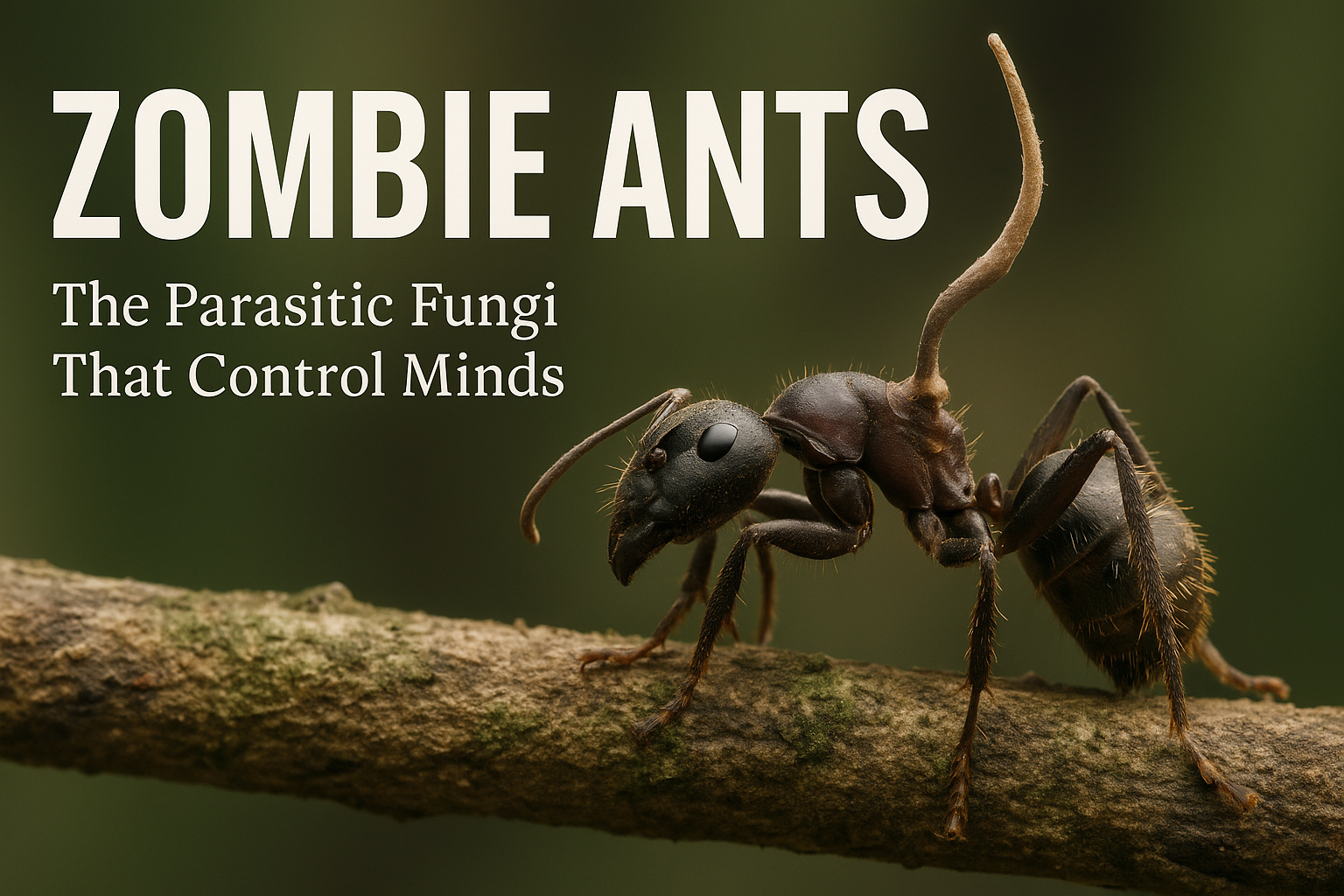Deep in tropical rainforests, a silent horror unfolds. An ant, once healthy and active, suddenly abandons its colony, climbs a plant, and clamps its jaws onto a leaf in a death grip. Within days, a spore-laden stalk erupts from its head, raining down infection on unsuspecting ants below.
This isn’t science fiction—it’s the work of Ophiocordyceps unilateralis, the “zombie-ant fungus.” This parasitic organism hijacks ants’ brains, turning them into mind-controlled slaves. Scientists are unraveling its terrifying biology, which could hold secrets for medicine, pest control, and even neuroscience.
1. The Life Cycle of a Zombie Ant
Stage 1: Infection
The fungus spreads via microscopic spores that attach to an ant’s exoskeleton. Within hours, enzymes dissolve the ant’s cuticle, allowing the fungus to invade its body.
Stage 2: Brain Hijacking
-
The fungus grows through the ant’s muscles and secretes mind-altering compounds.
-
Studies suggest it targets the central nervous system, altering serotonin and dopamine levels.
-
Infected ants wander erratically, a behavior dubbed the “zombie walk.”
Stage 3: The Death Grip
-
The fungus forces the ant to climb to a specific height (25 cm above ground, ideal for spore dispersal).
-
The ant bites down on a leaf vein in a “lockjaw” grip—a behavior never seen in healthy ants.
Stage 4: Fungal Explosion
-
The fungus consumes the ant’s insides, then sprouts a stalk from its head.
-
After 4–10 days, the stalk releases spores, infecting new victims.
2. How the Fungus Controls Ants’ Minds
A. Chemical Mind Control
Research in PLOS Pathogens (2022) found that Ophiocordyceps produces bioactive metabolites that:
-
Disrupt motor control.
-
Override hunger signals.
-
Manipulate temperature-seeking behavior.
B. Precision Puppetry
The fungus doesn’t just kill randomly—it ensures the ant dies in the perfect spot for spreading spores:
-
Humidity: 94–95% (critical for fungal growth).
-
Height: 25 cm maximizes spore dispersal range.
-
Direction: North-facing leaves in some species for optimal sunlight.
C. Host Specificity
Different Ophiocordyceps strains target specific ant species, evolving alongside them for 48 million years (fossil evidence shows ancient zombie ants).
3. Real-World Implications: From Horror to Hope
A. Medical Breakthroughs
-
Antifungal Resistance: Studying how Ophiocordyceps evades ant immune systems could improve human treatments.
-
Neurological Research: Its mind-control chemicals may inspire new drugs for Parkinson’s or depression.
B. Pest Control Potential
Scientists are testing modified fungi to target crop-eating insects—without pesticides.
C. Climate Change Threat
Rainforest destruction risks losing undiscovered Ophiocordyceps species before we can study them.
4. Could It Infect Humans? (Spoiler: No)
Despite The Last of Us hype, Ophiocordyceps can’t infect humans:
-
Our high body temperature (37°C) kills the fungus.
-
Mammalian immune systems are too complex to hijack this way.
However, other fungi (like Candida auris) pose real threats—making zombie-ant research vital for preparedness.
5. How Scientists Study Zombie Ants
A. Fieldwork in Rainforests
Researchers in Thailand, Brazil, and Florida track infected ants using:
-
Tiny radio tags.
-
3D imaging of “graveyards” (clusters of dead, fungus-covered ants).
B. Lab Experiments
-
Ant colonies infected under controlled conditions.
-
Genetic sequencing to identify mind-control genes.
C. Citizen Science
Apps like iNaturalist help log new zombie-ant sightings worldwide.
Conclusion: Nature’s Most Chilling Masterpiece
Ophiocordyceps reveals evolution’s darkest creativity—a parasite that turns animals into puppets. Yet, its gruesome biology may unlock medical miracles and sustainable pest control.
One thing’s certain: the zombie-ant fungus is far stranger than fiction.




Leave a Comment